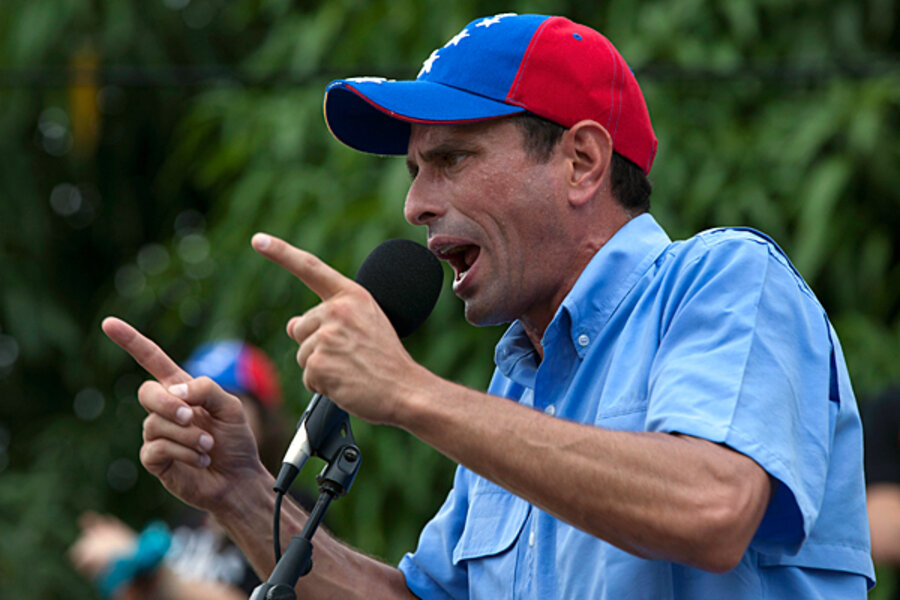Does Chavez challenger have a shot in Venezuela's presidential race?
Loading...
• David Smilde is the moderator of WOLA's blog: Venezuelan Politics and Human Rights. The views expressed are the author's own.
[Three] weeks ago, both Bloomberg and Reuters released the results of Venezuelan polling firm Datanálisis’ August Omnibus (fieldwork July 16 to August 9). As a client of Datanálisis I cannot legally confirm or disconfirm these numbers since it was not a public poll. However, I can dig down to the next layer of the Omnibus to look at some of the trends.
One of the most discussed issues in Venezuelan polling has been the number of undecided voters – with opposition supporters especially suggesting that a large number of undecided voters is simply impossible and must be an artifact of pollsters’ methods or a presumed “fear factor” (i.e. that people who plan to vote for Capriles are afraid to say so). However, if you remember that a presidential election is basically a choice between two candidates, not a projection of ideal preferences, it is easy to understand that a good percentage of the voters might have a pretty well formed critical opinion of both sides and not be sure which of two very different choices they will eventually support.
Indeed Datanálisis’ polls have been showing a good deal of consistency with previous elections during the Chávez period, in which the large number of undecided voters progressively diminishes as the election approaches. In the past four months they have steadily declined by 15-20 percent in each poll from 31.4 percent in May to 18.8 percent currently as more people decide who they will support. This is exactly the opposite of what one would expect if a “fear factor” were at work. In the latter case the number of undecided voters should increase as the election gets closer and the political climate gets hotter.
RELATED: Think you know Hugo Chavez? Take our quiz!
The good news for Capriles is that Datanálisis shows the undecided vote breaking 4 to 1 towards Capriles between their last two polls. 81.4 percent of the undecided voters who decided, did so for Capriles, while 18.6 percent decided to support Chávez. If we project the same 4 to 1 advantage in favor of Capriles onto the 18.8 percent that is still undecided, Capriles would gain 15.3 percent and Chávez only 3.5 percent, leading to a statistical dead heat with Chávez at 50.3 percent and Capriles at 49.6 percent.
However, Datanálisis does not seem to think this is what will happen. When they project what they think the undecided will do they get Chávez at 47.6 percent and Capriles at 37.8 percent. This is probably because their analysis of data from May suggested that the undecided voters largely mirrored the decided voters in their probable voting tendency. In addition, it is worth pointing out that this changes from month to month. The July Omnibus showed that undecided voters were breaking towards Capriles only 55 percent to 45 percent. Datanálisis probably thinks that after Capriles’s gains with undecided voters between July and August, the undecided voters who are left will tend towards Chávez. Nevertheless, it is interesting to note that Capriles has a theoretical path to victory through undecided voters.
However, some of the underlying numbers make an Capriles surge look unlikely. First, while Chávez’s positive evaluation has dropped from its high of 65 percent in February, it is still at an enviable 55.8 percent. Datanálisis looks historically at elections in which Chávez is a candidate or one of his proposals is at stake. They show that electoral support runs about even with job approval or only slightly behind. Using this as a basis they project a final electoral result of 55.8 percent for Chávez against 44.2 percent for Capriles.
Even worse news for Capriles is that levels of “trust” in Chávez look more like 2006 than 2010. Two years ago, before the 2010 parliamentary elections over 60 percent of respondents distrusted Chávez. This distrust had steadily increased from the time of the closing of the very popular RCTV through 2010 as the economy was hit by the worldwide recession and Venezuela was suffering from an electricity crisis. Now levels of distrust have descended to 40 percent and trust is at 46 percent. These are levels that have not been seen since Chávez’s landslide win in 2006. Perhaps even worse, distrust in Capriles is at 53.5 percent while trust runs 20 points behind at 31.3 percent. This shows that he has had a hard time gaining the confidence of average Venezuelans beyond his base.
Respondents’ perceptions of the situation of the country have dropped from 67 percent positive in May to 55.8 percent positive in July/August. But positive perception of personal situation remains around 80 percent and this is closely correlated with support for Chávez (+.811 (a perfect correlation would be +1.0)).
Finally, the government’s party advantage is only increasing. 37.9 percent of respondents identify with the PSUV, while only 12.5 percent identify with one of the opposition parties. “Party articulation” (whether or not an intended voter is in contact with the party of the candidate they intend to support) for the government is at 97 percent while it is at 55.3 percent for the opposition.
RELATED: Think you know Latin America? Take our geography quiz!
In sum, while a Capriles surge is theoretically possible, it does not seem likely. He has gained some ground, and has shown, at least for a month, the ability to win over the undecided votes with the strong majority he needs. But the underlying numbers make a last month surge look improbable. Chávez has a strong advantage based on his job approval, levels of trust, and respondents’ positive assessment of their personal situation. Chávez also appears to have a formidable advantage in party mobilization.
– David Smilde is the moderator of WOLA's blog: Venezuelan Politics and Human Rights.





